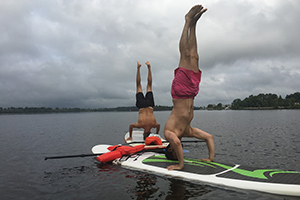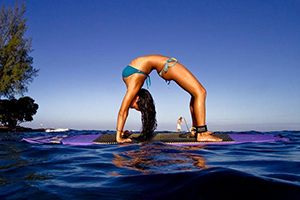If your yoga routine is more “chill out” than “heart pumping,” it may be time to move your practice to a stand up paddle board, better known as SUP.
With an unsteady platform, doing yoga on a SUP forces you to engage your core for a deeper strength-building workout. And let’s face it – yoga is so much more fun when you’re outdoors and on the water.
If you’re thinking of dipping your toes into SUP yoga, you may be wondering how to buy a board. Use our guide below to find the right stand up paddle board for your practice.
Hull Type: Planing

There are two main types of SUP hulls: planing and displacement. If you plan to do yoga on your board, you want a planing hull.
Planing hulls are wide and flat, which makes them very maneuverable. As Wave Tribe points out on their blog, planing hull boards are designed to ride on top of the water, which makes them perfect for SUP yoga.
You can also use a planing hull board for:
- Surfing
- Fishing
- Downwinding
- Paddling
Displacement hulls, according to the Grey Duck Group, have a pointed bow, which makes them very similar to a kayak. These are better for racing and touring.
Construction: Inflatable
It’s not absolutely necessary to get an inflatable SUP board for yoga, but it will make your poses more comfortable.
What I like most about inflatable boards is that you don’t need a whole lot of space to store it. It can easily slide under a bed for storage in between uses.
You can also take it with you hiking or camping. According to Zen Girl Chronicles, every traveling yogi needs an inflatable SUP board.
If you want to work on your tree pose at a pristine lake that takes an hour to hike to, you won’t be stuck lugging around a big, heavy board for miles.
With that said, solid boards are a better choice for some people. They feel a little more stable, and they ride lower to the water.
The only gripe with the a solid board is that you need a lot of space to store it.
Size and Thickness
The size and thickness of the board will depend on your size. If you’re on the tall side, you don’t want a short board.
The video below talks about the importance of your height and weight when choosing a board.
There are three main lengths for SUP boards:
- Small: less than 9 feet long
- Medium: between 9 and 12 feet long
- Long: between 12 and 14 feet long
Small boards are ideal for surfers, shorter users and kids. Medium is great for all-around use, and is usually the size SUP yogis choose.
Long boards are better suited for touring.
The board’s width is another important consideration. The wider the board, the more stable the feel.
- Wide boards are at least 31″ wide
- Narrow boards are between 29″ and 30″
As you may have guessed, wide boards are better for yoga. They’re easier to stand on, and they’re slower than narrow boards, which are better for racing and touring.
Along with width and length, you want to look at the board’s thickness. Thicker boards are more stable, but they’re a little bit slower to respond. SUP yogis are better off going with a thicker board that feels more stable on the water.
Weight Capacity
SUP boards do have weight limits, so you’ll need to consider that when choosing a model. If the board can’t support your weight, it will feel unstable and be uncomfortable to use.
There are two things to look at when considering weight capacity:
- Volume: The board’s volume (listed as liters) will give you an idea of how much weight the board can handle. The higher the volume, the more weight the board can support. This post from Blue Surf better explains board volume and floatation in relation to body weight.
- Maximum Weight Limit: Most SUP board models will also list the maximum weight it can handle, which makes it easy to find a board that can support your weight.
Extra Features
Most SUP yogis need nothing more than a board and some time, but if you plan to use your board for other things or will be spending several hours out on the water, there may be a few extra features you want.
REI recommends considering the following convenient and helpful extras:
- Bungees or tie downs: If you plan to bring gear with you on the water, you’ll need a board that has bungees or tie downs. These are great for securing extra clothing, bags, coolers and other gear.
- Attachment points: Some boards also have special attachment points that let you secure fishing rods, cameras, seats and other items.
SUP yoga is a great workout, especially if you have the right board. The hull type, weight capacity and size are the two most important things to keep in mind when choosing a board. Construction (inflatable vs. solid) and extra features are really a matter of personal preference.


